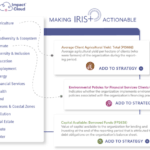Turning Intentions into Action: How to Boldly Implement Gender Lens Investing
At its core, investing relates to the process of evaluating risk and opportunity. Investors make calculated decisions about where to invest today based on the trends and patterns they believe will yield a positive return tomorrow. Impact or responsible investors in particular may invest to help realize a vision of the world they want to see in the future – say, one with more gender equality, clean energy or access to water.
Gender lens investing is an investment approach that seeks to realize a financial return while also considering the benefits of an investment to women and girls. These benefits can range from increasing the number of companies led by women, to supporting enterprises that promote gender equity, to backing businesses that benefit women through products and services.
At the recent Asia Venture Philanthropy Network (AVPN) conference in Singapore, more than 1,000 philanthropists, foundations, impact investors and social entrepreneurs from over 40 countries came together to discuss the importance of strategic, collaborative and outcome-focused approaches to investing. Conversations about gender lens investing were woven throughout the event and took centre stage during an in-depth workshop hosted by the Criterion Institute, a non-profit think tank and leading voice on the practice for financial institutions and the social sector. During the morning session, Criterion Institute President and co-founder Joy Anderson and Senior Program Manager Kristen Yee walked participants from the worlds of social finance and philanthropy through an action planning tool for gender lens investing, developed with support from Investing in Women, an Australian government initiative.
Practically, gender lens investing helps an investor make better decisions about where to allocate capital by incorporating a gender analysis into the investment process. This analysis seeks to uncover and make visible the gendered power dynamics and inequities that are present within different cultures, societies and economies. According to the Criterion Institute, “An analysis of gender relations can tell us who has access, who has control, who is likely to benefit from investments, and who is likely to lose out if power differentials are not taken into consideration. The point is to see and analyze patterns often unseen or undervalued that have implications for investments.”
Importantly, gender lens investing sees gender not as an “issue” to be solved, but rather considers the reality that gender cuts across all aspects of society, including our economic and financial systems, and that all investments have gendered impacts. Gender lens investing also helps investors move from metrics (counting the number of women on a board or leadership team) to analysis (valuing women as part of the decision-making process about an investment).
Designing an action plan for gender lens investing
While there is already strong evidence around the business case for investing in women, many asset managers and impact investors still lack an understanding of best practices about how to integrate gender lens investing into an organization’s investment strategy. The process can be complex and introspective, and can take time to implement effectively, and differ from institution to institution. But having an action plan like the one developed by Anderson and her colleagues is a good way to start the conversation.
First, consider your investment thesis, or the philosophy behind why you invest in what you do. How will your investments help realize a future that is more equitable and just for women and girls? What big gender patterns are at play in the market that could impact the risk or opportunity of an investment? Traditional market analysis can sometimes leave out important information that a gender analysis can uncover, helping investors make better decisions about an investment.
Second, think about how investments get made, and what underlying biases or assumptions related to gender are embedded in that process. Does gender bias factor into the referrals you trust when building your investment pipeline? How do you use your power and influence to determine what investments are valued during screening? When implemented effectively, a gender analysis can change perceptions during all phases of the investment process, helping to better see opportunity and de-risk investments.
Gender lens investing is a useful tool to uncover bias and assumptions in how investors think about investments, but it can also challenge the entrenched systems, structures and power dynamics that perpetuate inequality. Improving the makeup and culture of investment committees, increasing access to capital, or structuring deals with the right financial instruments that work well for women are all examples that begin to address the systemic change needed for a more inclusive investment ecosystem.
Turning Plans into Practices
Finally, once a clear gender lens investment thesis has been developed and investors have looked deeply at the gender-based assumptions and biases embedded in their investment process, an enterprise may look to implement practices that support a more fulsome strategy. How does your leadership and organizational culture contribute to the work of gender lens investing? What key performance indicators hold investors and asset managers accountable at all levels of the organization? Gender mainstreaming, or incorporating gender perspectives into policies, procedures, programs, administrative functions and other organizational activities can go a long way to support the successful implementation of a gender lens investing strategy.
The roadmap to develop a gender lens investing strategy and implement it across an organization is as varied as organizations themselves. Take the case of Patamar Capital, a venture capital firm focused on making investments in Asia’s fastest growing economies, including India, Indonesia, Vietnam and the Philippines. The company invests in scalable businesses that improve the livelihoods of people in poverty or without employment, with a focus on women and girls.
Having spent the last year working with the Criterion Institute and undergoing an internal process to incorporate gender lens investing into their overall investment strategy, Patamar Capital is now acting on what they have learned. In 2017 the firm launched an impact investment fund and adjoining accelerator program to finance the growth of small and medium-sized enterprises led by and supporting women in Southeast Asia. Patamar Capital made the first direct investment from their fund earlier this year, leading a round in Indonesia’s SayurBox, a distribution platform for fresh food sourced from local producers. From a gender lens perspective, SayurBox helps farmers, many of whom are women, gain better access to market opportunities through the platform.
As more and more impact investors in philanthropy and the financial sector look to funnel capital into investments that have a social and environmental impact alongside a financial return, the movement for gender lens investing will continue to pick up momentum. After all, looking at investments with a gender lens is not only good for business, it’s a necessity if we are going to shift the balance of power relations and create a more equitable future for women and girls.
David Venn is a strategic communications advisor with more than a decade of experience in the fields of philanthropy, international development and youth mental health.
Images courtesy of AVPN/Allison Hollowell.
- Categories
- Investing, Social Enterprise



